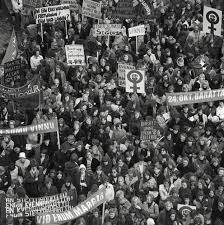|
The Day That Iceland's Women Went on Strike
January 4, 2018 The vast majority of Iceland's women went on strike on October 24, 1975. This included women who worked at home, looking after families and households. The stated reason for the strike was to call attention to how much less than men women earned, often for the same work. At the time, men earned 60 percent more than women.  The United Nations had announced that 1975 was International Women's Year. A handful of large women's rights organizations within Iceland planned events all year. One of the organizations, the Redstockings, pushed for and helped organize the strike. In the end, the title was changed from "strike" to "day off." The results of the protest against gender pay inequality was slightly organized chaos. Nurseries and schools shut, as did many factories, supermarkets, shops, and other businesses. Flights were canceled. Bank managers worked as tellers. Fathers took their children to work and plied them with candy and paper and colored pencils. The supermarkets that were open sold out of sausages, at the time Icelanders' favorite fast food. Men later referred to the day as "the long Friday." One of the things that 25,000 women did on that day was gather in Reykjavik, the capital, to hear leaders speaking and to discuss their concerns. Two members of Parliament were among the speakers. At the time, Iceland's population was 220,000. The country's Parliament, the Althing, passed a law in 1976 guaranteeing equal rights for women and men. The law did not specifically address gender pay inequality, despite the passage in 1961 of another law to that effect. Women in Iceland stop work every decade on the anniversary of the Day Off. |
Social Studies for Kids |
Social Studies for Kids
copyright 2002–2024
David White




